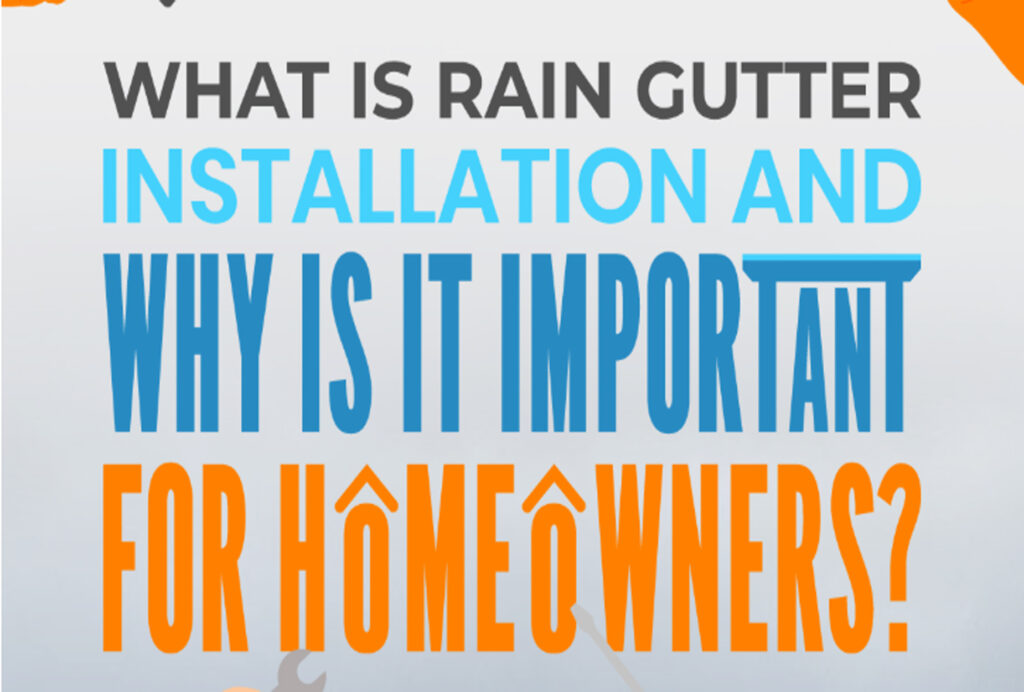People often overlook a simple yet essential home maintenance component – rain gutters. But this protective channel keeps your home in good condition and aesthetically pleasing.
A home’s foundation remains in good condition because its gutter directs rainwater away. Furthermore, parts of your home, like the door, sidewalks, or drive through the garage, remains dry and clean because gutters prevent rainwater from cascading down to these spots.
In this article, you’ll learn more about rain gutter installation and its benefits to homeowners like you.
What Is Rain Gutter Installation?
Rain gutter installation is the process of attaching a gutter system and downspouts to the edge of a roof.
When we say “gutter system”, this pertains to a network of several components that collect and channel rainwater away from the home’s roof and foundation. As the gutter system redirects rainwater away, the property is protected from potential water damage and erosion.
Without a gutter system, rain or any other form of precipitation (such as ice or hail), runs off to the ground and pools due to Earth’s gravitational force.
Now, this pooled water can saturate the soil around your foundation and make it less stable. Eventually, the foundation becomes weaker and forms cracks, breaks, and other structural damage. And if your property has a crawl space or basement, water can enter them due to persistent rainwater pooling.
How Does a Rain Gutter System Work?
Gutters operate by considering the physics of liquids. When rain hits the roof, it gains kinetic energy, and coupled with gravitational force, it tends to flow downward without any resistance.
However, the roof’s slope and surface material can influence the speed and direction of the rainwater’s flow. As water cascades, it encounters the gutter installed along the roof’s edge. The gutter’s job is to intercept this moving water and provide a channel for it to continue its journey safely away from the building. Since water always flows along the path with the least resistance, water can flow smoothly in a zero-blockage gutter.
What Are the Benefits of Rain Gutter Installation in Your Home?
There’s a reason why most homes have rain gutters installed. This water channeling system is a valuable investment that prolongs your property’s structural integrity and aesthetic appeal.
The benefits of rain gutter installation are as follows:
Avoids Flooding in the Home’s Interior
Your basement is prone to flooding without a gutter that will direct water away. A gutter keeps rainwater from seeping into the basement, which can lead to pooling and flooding (that is often costly and time-consuming to clean).
Protects The Property’s Foundation
A gutter lets rainwater travel down through downspouts and redirect into your home’s backyard or front yard, or a dedicated waste-collecting system. With this mechanism, rainwater will fall far from the home’s foundation.
It is important to keep your home’s foundation dry. When the foundation is frequently wet by rainwater, erosion may happen that weakens the foundation’s soil and leads to leaks in the property’s basement. When the foundation gets damaged, repairs and restoration costs can reach up to $5,000.
Preserves walls and entrances
Rainwater can cause stain formation and decay when it reaches the home’s walls, doors, and windows. If rainwater flows off the roof without any gutter for flow redirection, it often runs down the property’s surfaces Over time, this constant liquid exposure can lead to staining, discoloration, and even the growth of mold or mildew on walls. Moisture can also seep into cracks or gaps that can cause house materials such as wood, brick, or plaster to weaken.
Keeps your landscaping in good condition
Your home’s garden remains healthy and attractive if its topsoil is safe from excessive rainwater that can cause erosion. With a rain gutter, water flowing down from your roof will not reach your beautiful landscaping. Furthermore, with a gutter, no rainwater will knock over or topple your plants and shrubs.
Safeguards Roof Fascia from Rusting
The fascia is a horizontal board usually attached to the edge of a roof that runs along the lower edge, just where the roof meets the outside walls of a building. The main purpose of fascia is to cover and protect the ends of the roof rafters. By doing so, it shields them from rain, moisture, and pests.
With a rain gutter, the home’s fascia remains intact and free from rusting, as liquid overflow can hit the wooden fascia and cause its eventual deterioration.
Steps for Optimal Rain Gutter Installation
Gutters are often installed by professionals to ensure that they fit well on your home’s roof and can effectively redirect water to a safe spot. But if you are curious how a professional gutter contractor performs the installation, refer to the steps below.
Step 1. Home Assessment and Planning
The contractor will assess and examine the roofline, fascia boards, and downspout to identify the best gutter placement for optimal water flow. They will also measure the roof edges to determine the total length of the gutter needed for your property.
Step 2. Preparing Gutter Materials
Based on the analyses and measurements made in step one, the contractor will prepare the proper length and type of gutters, downspouts, hangers, end caps, elbows, sealant, and fasteners for the installation.
Step 3. Marking and Layouting
In this step, the contractor will identify and mark the points where the gutter will be installed. One of the first things they will consider is the gutter’s slope. Most contractors ensure that gutters are slightly angled (sloped) so that rainwater flows toward the downspouts and doesn’t collect or overflow. Typically, they follow the standard of about ¼ inch (6 mm) drop for every 10 feet (3 meters) of gutter length.
Then, the contractor will decide where the highest point of the gutter will be (usually farthest from the downspout), as well as the lowest point. Afterward, they will stretch a chalk line from the high point to the low point along the fascia board.
Step 4. Installing the Gutter
This step involves physically attaching the gutter sections to the fascia board along the lines and marks made during the previous step. The contractor begins by securing gutter hangers or brackets to the fascia board at the points marked. Then, they will lift the prepared gutter section up to the hangers/brackets. Afterward, the contractor will snap or screw the gutter into the hangers, which ensures that the front edge is slightly lower than the back edge.
Achieve Top-quality Rain Gutter Installation from L.I. Metals System
A home without a properly installed rain gutter is bound to lose its appeal and durability quickly. For this reason, you must invest in premier-quality gutter installation that will keep your property protected from water damage and erosion.
L.I. Metal Systems is a seasoned gutter contractor in Southern California. We provide top-notch, professional gutter installation services and gutter products made of world-class materials. We will analyze your home and roofing architecture to ensure that the gutter system we provide can prolong your home’s curb appeal and structural integrity.
Visit L.I. Metal Systems’ official website and schedule a consultation.





